Southport Village Voices
An E-Magazine by & for the Residents of Southport
Number 64, June 2015
|
|
|
|
|
|
|
|
A Father's Day Tribute
|
June 2013. Billie and I drove to Pennsylvania to celebrate Father's Day and his birthday with my father Aaron. That evening, we went to a favorite restaurant and "Pop" ordered steak, a treat he didn't often get at his assisted living home. Just minutes into our meal he suddenly looked startled and slipped from his chair. EMTs came and whisked him away.
An hour or so later, the doctor who had examined him at the hospital talked about a "heart event" and assured us that Pop was gone by the time he fell to the floor. It wasn't his first "heart event."
My father was 98 when he died, just a few years short of his announced goal of living to 102. We'd had no time to say "good-bye" or to assure him that we loved him, although he knew we did. We were shocked and sad. But after watching my mother live and die in great pain, I was grateful that his death came instantaneously. The days that followed were occupied with funeral arrangements, leaving little time for mourning. Pop was respected in his community and well liked; a big crowd turned out to see him off.
Pop was born in 1915, on a farm in central Pennsylvania, one of seven children. He graduated from high school, but his biggest accomplishment there was persuading his girlfriend "Etty" to marry him. Before they married, however, he bought a Model T Ford and journeyed south with his brother, where they worked in the Texas oil fields. Returning to PA, he married in 1937 and started a family. He was a peaceful man and had the good luck to be employed in a defense related job, which kept him out of WWII.
Pop's chief pleasure in life was roaming the fields and mountains of Pennsylvania. One of his early jobs, inspecting an oil pipeline, required him to walk alone for hundreds of miles in the Appalachian Mountains. He was a average fisherman but an excellent hunter -- bringing down a deer with a single shot when he was 90 -- and some unusual entrees turned up at supper. He had a big garden (in which I toiled, reluctantly). We enjoyed its bounty in the summer and my mother canned the excess for winter meals. He was handy and could build or make most anything we needed, including toys for us kids.
Pop's life experience might be considered unexceptional, but he was hard-working, honest and devout, committed to his family and faithful to his wife of 74 years. In a word, he was a good man. Perhaps that, in itself, is exceptional.
Now, I keep his picture posted on the refrigerator door, and sometimes I momentarily forget that he's gone and think, "I have to call Pop." Then I remember that he isn't answering anymore.

David Kapp, editor
|
|
 |
|
|
SOUTHPORT PROFILE
Forrest Pirovano: A Man of Many Careers
an interview with Art Wagman
|
|
| |
Forrest launched his current career on Main Street in
Woods Hole, painting pictures for passers-by.
|
Several years ago while walking along the picturesque main street of Woods Hole, I noticed a crowd gathered in front of the old fire house next door to the Woods Hole Community Center. My curiosity getting the better of me, I went over to investigate and found that the focus of attention was an artist. On his large canvas, mounted on an easel, he was painting an idyllic Cape Cod scene - a sailboat floating serenely on a glassy blue sea. The artist, in his most recent incarnation, was Forrest Pirovano.
Forrest was born in Wood Ridge, NJ, but when he was 14 years old his dad was transferred to Canton, Ohio. After high school he enrolled in a Bachelor of Fine Arts program at Kent State University but left at the age of 19 to join the Navy. While stationed aboard the aircraft carrier Essex during the Vietnam War, his ship was in an accident with a nuclear submarine and was sent to Boston for repairs. It was there that he met Shirley. They married in1967.
After a three-year tour in the Navy, Forrest enrolled in the Art Institute of Pittsburgh and following graduation came east. He worked for an ad agency and then did art and design work for companies including Mammoth Mart, Stop & Shop, and Iandoli's, among others. Along the way he taught art and design at Tri-County Regional Vocational School and did freelance advertising to supplement his teaching income.
In 1982 he started an ad agency producing and printing circulars for super markets and other retail establishments. "We had clients from New Jersey and Pennsylvania as far west as Buffalo, New York. Once a week, our small fleet of six 24' box trucks and four vans loaded up at a printing plant outside of Philadelphia and delivered the circulars to our clients or mail houses. So at the same time that I was in the ad business I was also in the trucking business. But the trucks were not being fully utilized so I started doing contract trucking for Roberts Express out of Akron, Ohio."
|
| |
Driving as part of a NASA team took Forrest all over the country, delivering satellite parts and defense cargo.
|
In 1987 Forrest sold his ad agency and bought a small van, and until 2001he did all kinds of trucking services, all over the country. "We were what they called an 'expedited freight company.'' He joined a team basically working for NASA. Their services ran the gamut from "white glove" trucking - carrying small, often delicate high priority items - to escort and pilot services for huge oversized shipments for NASA, defense contractors and other government agencies. Some of the items escorted were satellites and parts of satellites, weaponry and even the Hubble Space Telescope.
"I love to drive," Forrest says. "Shirley traveled with me and was my co-driver for 11 of those years. Driving as a team we were able to make cross-country runs. I had to retrofit the van to accommodate a sleeping area. We toured the country. It was an exciting, interesting time; I drove about two million miles and went through three trucks."
|
| |
Forrest had the opportunity to drive his Duck Boat in two Boston Red Sox World Series championship parades. Here, he & Shirley pose in Fenway Park with the Series trophy.
|
Forrest and Shirley have been residents of Southport since 2003. When I ask, "What brought you to Southport," his one word answer is "Shirley." After graduating from Lesley College in Cambridge and earning a Masters degree from Wheelock, Shirley became a reading specialist teaching for 27 years for the Norwell Public Schools. They were living in Marshfield at the time, and Shirley would come to the Cape to visit friends. She had always wanted to live here and had seen and been impressed by Southport. Forrest also liked the amenities, the golf course, and the Village Center. "I really love it," he says, "and we are very happy here."
|
| |
"Sven the Viking" had a ten-year career as a Duck Boat driver on the streets of Boston and the waters of the Charles River.
|
In 2001, Forrest heard that Boston Duck Tours was looking for drivers. "I had to go through a three-part audition before I was hired. You had to become well versed in the history of Boston as well as licensed to operate this huge vehicle." Forrest became known at Southport as "The Duck Boat Driver." Big, amiable, quick to smile, Forrest in his Duck Boat persona of "Sven the Viking," tooled around the streets of Boston and sailed up the Charles River, quacking out greetings to thousands of tourists, visitors and home folks while performing his duties as official tour guide and licensed duck boat captain. During his Duck Boat tenure, Forrest was lucky to have the opportunity to captain his boat in two World Series parades for the Red Sox. "As captain of a Duck Boat, I had the chance to meet actors and politicians and some really terrific people. It was a blast," he says. "I did that for ten years but I always knew that my last job would be painting. That's how I pictured myself, painting."
"I set up my easel in front of the old firehouse in Woods Hole and painted just for the joy of it. I hadn't even thought about selling my work but I was working one day when a young couple from Cleveland, Ohio, introduced themselves. They were on their way to Martha's Vineyard but wanted to buy the piece I was working on. They offered me $100 and picked up their new painting when they returned from the Vineyard. As a matter of fact, they were with their entire family and they ended up buying three pieces. That was my first real sale and it gave me the idea that perhaps my work was salable."
I asked Forrest about his work and his technique for creating his art. "I usually start from a small sketch or perhaps a photograph and then move up to a 5 x 7 in which I compose the subject, decide on my colors, etc., then I use that to paint an 11 x14 piece. Those are actually my roughs for my larger paintings."
|
| |
Forrest outside of his highly successful gallery in
Mashpee Commons.
|
Two summers ago Forrest rented a small gallery at 12 Market St. in Mashpee Commons across the walkway from Bleu (the French restaurant) as a test to gauge the level of interest in his work and his subject matter. The response has been amazing. His friend and Southport neighbor Sandi Abrams helps him out with the day-to-day operation of the gallery, keeping him organized, framing his work, allowing Forrest to focus on his painting, which often includes special commissions. Over the years Forrest has been very magnanimous, donating original oil paintings for the Southport Scholarship Committee raffle.
We talk about his various careers and the unforeseen twists and turns of life. "You know," Forrest says, "when I was a small boy I wanted to become a truck driver and often, driving around the country, I thought how lucky I was to have been able to do that. Also, I was born with a talent to draw and now I've achieved another life-long goal - making art." "So what's your next career," I ask. "This is it," he says. "I love what I'm doing and I'm going to keep doing it as long as I'm able and people want to buy my work."
|
|
| |
I used to comb the beach
looking for that perfect shell,
the kind you'd find in a seaside
gift shop all shellacked up and
glossy but now I look for the
tide worn shell, tumbled by
the waves and tossed up on
the beach, pecked by hungry
beaks, weathered and crazed
by the sea. A shell with
character, a shell that tells
a story.
Perfection is overrated, it's
an illusion. It's what we see
in others that we desire for
ourselves when we should be
embracing our flaws. Our
imperfections are what make
us us. Our mistakes are our
own lessons.
We are like the shells, all
different sizes and shapes,
all strewn about and gull-
pecked, all with a story of our
own to tell.
|
|
NON COMPOS MENDES
Bob Mendes
|
-
I must be missing something. An editorial in the Cape Cod Times told us about a granite memorial recently erected in Provincetown to honor 14 people who died of smallpox between 1855 and 1873. I have as much empathy as the next guy, but I must ask: Have those responsible for this memorial nothing better to do with their time?
-
After almost running over a turkey, I mentioned the incident to my friend Odin Tidemand. The following conversation took place:
Bob: The other day I almost ran over a turkey that came out from behind a construction truck on Leisure Green.
Odin: They should put up signs to warn the turkeys.
Bob: What kind of signs?
Odin: (after some thought): Maybe a picture of a roast turkey on a Thanksgiving platter. That should make the point.
-
For golfers only: If you fire a gun at a guy named Mulligan and miss him, do you get another shot?
-
As I've said before, all it takes to be able to write this column is a subscription to the Cape Cod Times. For example on just one day, May 8, the following stories appeared in that worthy journal.
A woman was charged with stabbing a man in the shin with a pen. Perhaps she was trying to prove that the pen IS mightier than the sword, but in the shin -- for God's sake. Man up lady, go for the midsection!
The sheriff in Jonesboro, Georgia shot a real estate agent showing a model home and called it a "tragic accident." He told the 911 dispatcher that he was conducting police training activities and vowed to continue his law enforcement activities.
In Charleston, South Carolina, a sheriff's deputy, responding to a home break-in, shot the homeowner in the neck while the two would-be invaders escaped -- on bicycles -- unharmed.
-
Having grown up (my wife will debate that) and spent my formative years in a hamlet called Manhattan I was an ardent Yankee fan. I could never understand why the rest of the civilized world hated -- really hated -- the Yankees. I know now. It was a thing called "Success." For the same reason, Tom Brady and the Patriots will never live down what is called "Deflategate." It has nothing to do with right or wrong, guilty or not guilty. It has to do with "Success" and it has to do with jealousy.
-
Why do people who send spam messages even bother? Nobody reads spam.
ASK MISS INFORMED
Dear Miss Informed:
I live in Southport on Cape Cod and I want to know, when will enough be enough? When I drive the span of Leisure Green south of the golf course it's an absolute nightmare. Ruts have become chasms; vision is impaired by trucks halfway out into the street, and now there's a metal plate on the street that shows all signs of shifting position and swallowing a car or two. What do you suggest?
Sucking it up
Dear Sucker:
I've spoken to a knowledgeable source and he says this is a temporary situation. Construction will be finished, the road will be repaved and all problems will be solved by the end of June, and if not then, definitely by the year 2020.
M.I.
|
|
New In The Neighborhood
snapshot interviews and photos by Andy Jablon
|
 Michael & Lori McBride Michael & Lori McBride
5 Drivers Lane. Moved in November 2014.
Originally From: Michael: Seaford, NY; Lori: Melrose, MA
Previous Residences: Baldwin NY, Ashland and Hopkinton, MA
What Kind Of Work Did You Do?
Both are still working full-time. Michael is a civil engineer and Lori, formerly in banking, now works as an administrative assistant at Hopkinton Middle School.
Why Southport: We were looking for a golf community near the beach. We liked the idea of a gated community with lots of activities.
Like Best About Southport: People are friendly. Golfing, the clubhouse and pools, and there's lots to do, even in the winter.
Like Least: We're here mostly on weekends and we sometimes miss signing up for activities on time. It would be great to have an online registration process as well.
Want To Get Involved With: Michael: golf and sporting events. Lori: golf, exercise classes and social events
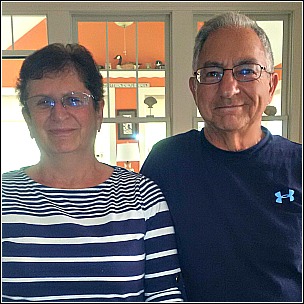
Charlie & Carol Aftosmis
86 Leisure Green Drive.
Moved in December 2015.
Originally From: Charlie: New Haven, CT: Carol: Bolton, CT
Previous Residences: Nashua NH,
East Falmouth, MA
What Kind Of Work Did You Do? Charlie was an acquisitions engineer;
served in the Air Force for 30 years.
Carol was an office manager
Why Southport: We knew about Southport from living in East Falmouth
and we wanted to downsize.
Like Best About Southport:
Nice amenities, gated community, everyone is friendly.
Like Least: Many things in and around our home are not finished.
Want To Get Involved With: golf, swimming, yoga and socials.
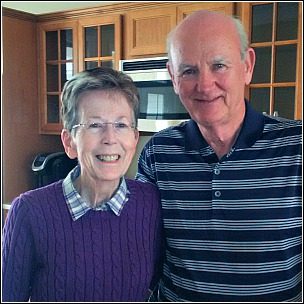 Bill & Eileen Ryan Bill & Eileen Ryan
47 Grayhawk Drive. Moved in May 2015.
Originally From: Both are from Worcester, MA. They met in first grade and knew each other all the way through school and afterwards.
Previous Residence: Harwich, MA
What Kind Of Work Did You Do? Bill worked for Nissen Bread as chief financial officer. Eileen taught English and the sciences to middle school students in Rutland, MA.
Why Southport: Wanted to downsize and were looking for new construction and affordable homes on the Cape. We go to Florida for much of the year and wanted to feel secure about leaving our Cape home.
Like Best & Least About Southport: We're too new to know what we like or dislike.
Want To Get Involved With: Bill: golf and woodworking. Eileen: golf and mah jong.
Want Your 15 Minutes Of Fame?
If you've been here less than a year, volunteer for a snapshot interview.
Or nominate a neighbor.
It's painless.
Andy Jablon: andy@wvpboston.com
|
Dandelions:
A Lesson in Genetics vs. Environment
by Ernest Ruber
|
I'm writing about one of my favorite flowers, the beautiful dandelion. Most grass lovers hate this flower because it is invasive, hard to pull up and tends to open patches in the grass. But an examination of growth patterns in dandelions may lead us to broader thoughts about humans and, indeed, all living things.
The word dandelion comes from the French, " dent de lion," i.e., lion's tooth, and refers to its tooth-like leaves. Its prominent bright yellow flower, about half an inch to one inch in diameter, is packed with tiny petals,many of which have attached reproductive structures like pistils or anthers. Botanists define such flowers as compound or composite, i.e., many tiny flowers packed together, and they have their own large family -- the Compositae (e.g., daisies, asters, bonesets, thistles).
Dandelions show an interesting growth characteristic. In mowed areas they flower while very low in height (Figure 1). In unmowed areas, next to a wall for example, the plant grows taller (Figure 2).
Biologists speak of variants in a population of a species as either ecotypes or ecophenes. .
- Ecotypes are based on hereditary differences, these being demonstrated by growing from seed or transplanting.
- Ecophenes are not genetically different but rather respond to environmental effects by varying their growth.
Transplanting immature forms, even seeds, is a method for testing which kind of variant is seen. This question has been studied in the common dandelion, and while most variants are ecophenes -- simply environmental, a few actually are ecotypes, --
hereditarily fixed.
Such observations and questions are commonly faced by plant ecologists since plants display much greater plasticity than do animals. Typically, when you get above 4800 feet or so (depending on exposure to wind and sun), you see plants that are dwarfed, like spruce trees growing no more than two feet high. The question again arises: ecotype or ecophene? Answers to the question typically mix observation (shade? wind? soil?) with experiment (transplanted adults or seeds).
We speak of plants that "are dwarfed" when the effect is environmental and as "dwarf" when it is fixed genetically. So, on Mt. Washington in New Hampshire, there exists a dwarf willow growing only six inches high, perhaps 12 inches under excellent conditions, but also dwarfed spruces growing only two feet high but which grow into tall trees from seed when protected from wind and ice shear. This high altitude area is said to be an alpine tundra, and some of the plants growing there are not found in the lowlands until you reach the geographical tundra perhaps 600 miles to the north. Why not in-between? Competition turns out to be the answer.
All of this is a linkage between evolution and ecology. Genetics permits variants; those with advantages survive and leave more seed than their neighbors. Over time the variant takes over. Genetically, some variants are more plastic than others. These display growth variations "as needed," under environmental pressure. Such variants may disperse very well into new, open environments, but if the environment is a stable one, the variants that fit it best will be selected and survive to leave more seed, and variation within the group may decline as the other variants fail. Genetics provides the raw material of evolution, but natural selection, the environmental factor, determines survival. Many interesting aspects of the dandelion, such as the presence of a taproot and the classic globular seed structure, all fit into the reasoning above.
|
| |
Dandelion admirer Ernie Ruber (in the floppy hat) leading a Southport nature walk. Southport's nature trail, with posted plant descriptions, is his work, too. Photo: Andy Jablon
|
All living species must reproduce if they are to survive. There are many physical and physiological aspects that may make a species more or less fit. Our dandelion has 'chosen' to reproduce by rapid production of seeds that are parachute sailers. The plant grows low-lying, spreading leaves that capture sun and shade any competitors beneath them. This aspect is not affected by mowing. But to disperse its seeds efficiently, the dandelion must build a 'tower' from which to release them, and this is where mowing comes in. Short stemmed flowers avoid the blades, but their stems do not lift seeds into the wind as efficiently as taller forms, whose stems and seeds are lopped off by the mower. This push/pull of features with different adaptive values occurs in all plants, depending on the environment in which the individual finds itself. Evolutionary survival is competitive; predators, competitors and parasites come and go. Can you cope?
If you have soaked this up (with your roots or leaves), you now know a lot more about ecology and evolution than most people do. We humans often wonder about the effects of heredity vs. environment on members of our own species. It is much more difficult to determine such things in humans because ethics preclude experimentation to a limited extent. Yet we do know or suspect numerous things. Certainly, sending children to school implies a belief in plasticity of mental development although we also recognize limitations to this plasticity in children born with certain gene forms. These broad questions take us far beyond the scope of this article. Hope you've enjoyed this.
|
|
Argentina & South American Cruise
by Liz Rogers
|
We left Southport on January 10 for our 2015 winter adventure. It began slowly -- soaking up Florida sunshine for five weeks -- but the pace picked up in mid-February when we boarded a plane for Buenos Aires and a 10-day private tour in Argentina. We arrived jet lagged and tired at 8:00 in the morning and were whisked to the Magnolia Boutique Hotel in the Palermo district, our home for the next two nights. After a much needed nap we explored this trendy part of town, had lunch and got lost on the way back to the hotel. Our Vaya Adventures travel agent Gabrielle took us to dinner and a milonga, a local tango dance hall. It was a wonderful evening of watching residents demonstrate their tango moves.
The next day it was time to learn about Buenos Aries. Our wonderful guide Alejandro showed us the highlights of this fascinating city, including the famous Recoleta Cemetery and the Plaza de Mayo; the Teatro Colon opera house; San Telmo, the city's oldest barrio (neighborhood) and La Boca barrio, a popular tourist destination. Unexpected treats were seeing the church where Pope Francis preaches when he is in Buenos Aries and the famous balcony where Eva Peron withdrew as a candidate for vice president of Argentina.
Later, we attended a professional tango show, El Viejo Almacen (see above). The dancing was amazing, very quick and precise, with all the little 'kick steps' that make you wonder how the dancers manage to avoid kicking their partners.
The following day we took a flight to Iguazu Falls National Park (see below), on the border between Argentina and Brazil; 80% of the 275 waterfalls are in Argentina, the rest are in Brazil. Their breathtaking beauty is indescribable and photographs don't do them justice, they have to be experienced. While walking the trails, we saw many varieties of birds, coatis, lizards, monkeys and even a tarantula out for a stroll. We splurged on a two-night stay in a "falls view" room in the Sheraton Iguazu Resort and Spa, where a swim in the outdoor pool and a Piņa Colada brought an end to a perfect day in subtropical Iguazu.

Then we were off to Mendoza, at the heart of Latin America's largest wine-producing region and home to the best Malbec wines. During our four-night stay at the boutique hotel Finca Adalgisa, located in a small family-owned vineyard, we took a wonderful winery tour. At the last of three wineries, we enjoyed a gourmet lunch with a wine pairing. So many glasses! We also took a scenic tour of the Andes Mountains foothills, spotting guanacos and a condor along the way. The highlight of this drive was viewing Mount Aconcagua, at 22,900' the highest mountain in the Americas. We spent our last day relaxing at the hotel and taking a cooking class and flew back to Buenos Aires the next morning.
Our final adventure in Argentina was a visit to the Estancia (cattle ranch) El Ombu, where we had a wonderful day horseback riding with the gauchos, enjoying a gourmet meal and watching an amazing horse training show.
On February 28 we boarded the Golden Princess, our home at sea for the month of March. Our first port of call was Montevideo, Uruguay where we joined a walking tour. Some of the city's varied architecture has been beautifully restored while other buildings are badly in need of repair. In one of the major city plazas, "Bimboo" brand bread trucks were circling the plaza and protesting against something - not sure what - maybe they wanted a name change. At our next port, Puerto Madryn, on a wonderful van tour, we saw guanacos, rheas, owls, armadillos, sea lions, elephant seals and Keith's favorites - Magellan Penguins.
On March 8, we docked in Ushuaia, Argentina, the southernmost city in the world, with a population of 70,000. The landscape is breathtaking with the Andes Mountains on one side and the Beagle Channel on the other. There we visited a small island that hosts one of three colonies of Magellan Penguins in Tierra del Fuego. Gentoo and King Penguins were also present, and Keith finally got to mix it up with thousands of penguins!
It rained on our stop in Punta Arenas, Chile, dampening our pleasure on a city bus tour, and the following day was a rock and roll sea day with waves from 7.5 to 12 feet. Things settled down after that and it was smooth sailing to Puerto Montt, Chile, known as the "northern door to Patagonia." On another van tour we began in the city, then viewed three amazing volcanos, Lake Llanquihue, one of the largest lakes in South America, and the Pertohue Rapids, formed when lava from volcanic eruptions blocked the river's course. It was a great day and the weather was starting to warm up again!
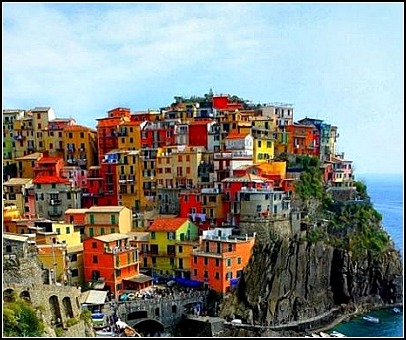
Half-way through our cruise and we're in Valparaiso, Chile, where we took a walking tour of this very hilly and colorful city (see photo on the left). From the time of the California Gold Rush in 1849 until the opening of the Panama Canal in 1916, this was one of the most important ports in South America and one of the richest cities in the world. After the opening of the canal the city went into decline but it is now reinventing itself and several sections are designated as UNESCO World Heritage sites. We rode a funicular to the top of one of the city's 45 hills, walked the winding, narrow, steep streets and admired the many beautiful city art murals.
Our last port in Chile was La Serena, the second oldest city in the country and capital of the Coquimbo Region. On a van tour we explored the Elqui Valley, a fertile strip of land in the middle of a desert plateau, and we viewed the famed astronomy observatories from a distance. Being a tourist is thirsty work so we were glad to visit the National Drink Distillery Factory to learn about and taste a Chilean brandy called Pisco.
Then we said adios to Chile and hola to Peru. Our first Peruvian port was Pisco, located in one of the driest deserts on earth. Here we took the amazing Islas Ballestas Wildlife cruise, on which we saw thousands of birds, including Humboldt Penguins, as well as dolphins and great herds of sea lions and their pups (see above).
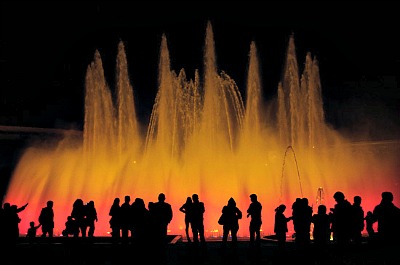
Next we had two wonderful days in Lima. Another van tour, this time with Haku, a non-profit that uses its earnings to help people living in shanty towns, was led by an Incan Indian who gave us insights into the lives and challenges of the Peruvian people, especially those of Incan descent. During our stay in Lima, we also toured the city's highlights, including a walking tour of the bohemian Barranco District, Saint Francisco Monastery and catacombs, the ancient Inca village of Pachacamac, and the dazzling night time Magic Water and Light show. It was a delightful and very busy visit (on the left).
King Neptune held court on the pool deck as we crossed the Equator! We were transformed from Polliwogs to Shellbacks and have the papers to prove it. We can only imagine how jealous you must be.
Confident of our new status, we disembarked at Puntarenas, Costa Rica. We organized a small van tour and had a wonderful day seeing capuchin and howler monkeys, scarlet macaws, pelicans, herons, egrets, and many other birds. We also took a beautiful boat ride on the Tarcoles River and saw humungous crocodiles. A "Crocodile Man" enticed a few out of the water so we could see a full size one, which in one case was 18' long.
|
| |
So much good wine. So little time to enjoy it.
|
|
|
| |
There's nothing like an outdoor shower.
|
|
The next day found us in San Juan del Sur, Nicaragua. The countryside was beautiful, with active volcanoes, lakes and lovely towns. We took a boat ride on Lake Nicaragua (tenth largest lake in the world) and saw several of its 367 islands including one with many friendly (begging) spider monkeys. It was also a great place to see many types of birds. The final port of the cruise was a half-day stop in Cabo San Lucas, Mexico. Our wonderful winter adventure ended on March 31 in Los Angeles, where we boarded our flight to Boston, arriving at Southport just after midnight on April Fools Day.
|
Seen at Southport
|
|
| |
Many new tennis players attended the season's first "Tennis & Dine" party. Photo: Andy Jablon
|
|
| |
"From a Distance" (detail) is one of the paintings Roseanne Francesconi will be showing at the
Mashpee Public Library in June.
|
|
| |
Arlene Rucci & Betsy Lord show off their prize winning hats at the Southport Spring Tea Party. Photo: Carmen Marino
|
|
|
| |
Getting ready to roll, at the bowling party at
The Lanes in Mashpee Commons.
Photo: Larry Cron
|
|
|
Southporters enjoyed singing at the Broadway Tunes Sing-Along; Sandy DiMartino played the keyboard. Photo: Lynn Robinson
|
|
| |
Mike & Karen Smith and a friend help themselves to pizza after bowling at The Lanes.
Photo: Larry Cron
|
|
|
Contributors to the
May 2015 Edition
Southport Village Voices
|
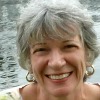 Lydia Biersteker grew up in Somerville, Massachusetts. She met her husband Dale on the beach at Falmouth Heights in 1969, while he was stationed at Fort Devens. After Dale retired in 2005 from his executive position with the USPS, they moved to Vero Beach, Florida but decided that they preferred New England. They moved to Southport in 2011. Dale plays golf, and Lydia likes gardening, walking, writing poetry and short prose, exploring genealogy, and lunching with friends. Together, they enjoy dining, exploring wineries and brew pubs, walking, traveling and playing with their grandkids. Lydia Biersteker grew up in Somerville, Massachusetts. She met her husband Dale on the beach at Falmouth Heights in 1969, while he was stationed at Fort Devens. After Dale retired in 2005 from his executive position with the USPS, they moved to Vero Beach, Florida but decided that they preferred New England. They moved to Southport in 2011. Dale plays golf, and Lydia likes gardening, walking, writing poetry and short prose, exploring genealogy, and lunching with friends. Together, they enjoy dining, exploring wineries and brew pubs, walking, traveling and playing with their grandkids.
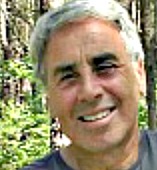 Andy Jablon Andy Jablon owns a television production company in Watertown that provides crews to shoot stories in New England for the major TV networks. As producer, he interviews all sorts of interesting people on a regular basis. His wife Tracy Tebbutt works at a cancer pharmaceutical company in Cambridge. Since July 2014, they split their time between Southport and Boston, depending on work schedules. Both are enthusiastic cyclists, riding their bikes along the Charles River to work in almost all kinds of weather. They relax by walking, biking, playing tennis and soaking in the hot tub.
 David Kapp, with his wife Billie, moved from Connecticut to Southport in 2009. David retired from a career as a university library administrator, after working in the libraries at Brandeis, Harvard and the University of Connecticut. He was a building consultant for the planning of a number of major university libraries and was, for many years, the editor of Connecticut Libraries. Billie enjoyed a career as an educator and social sciences consultant. The Kapps are frequent visitors to Hawaii where their daughter, son, grandson and many other family members live. David Kapp, with his wife Billie, moved from Connecticut to Southport in 2009. David retired from a career as a university library administrator, after working in the libraries at Brandeis, Harvard and the University of Connecticut. He was a building consultant for the planning of a number of major university libraries and was, for many years, the editor of Connecticut Libraries. Billie enjoyed a career as an educator and social sciences consultant. The Kapps are frequent visitors to Hawaii where their daughter, son, grandson and many other family members live.
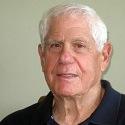 Bob Mendes Bob Mendes began his career as an advertising copywriter at Doyle Dane Bernbach in NYC before becoming senior vice president of marketing for a west coast department store chain. He left that position to start Pacific Sports, a sports and general marketing agency. There he developed "The Reading Team," a children's literacy program sponsored by the NFL and the American Library Association, using NFL players as literacy role models. Bob is the author of "A Twentieth Century Odyssey, the Bob Mathias Story." After retiring, he served as executive director of the Glendora, CA Chamber of Commerce. When grandson Adam was born, Bob and Bette moved to Cape Cod. He's had a number of part-time jobs, has written two more books, and volunteers. Bette serves on the Board of Governors and volunteers at the Falmouth Jewish Congregation. Their son Steve, a pediatrician, lives in Marion with his wife Sarah and their children; a second son, Jeff, practices law in Indianapolis.
 Liz Rogers and her husband Keith moved to Southport from Rhode Island in 2012. Liz retired from a career as a professional conservationist with the USDA's Natural Resources Conservation Service. Liz and Keith have a son living in RI, whose children, Cody 13, Libby 8, and Abby 7, love to swim in the Village Center's indoor pool. Liz and Keith enjoy their home on Chadwick Court and Cape Cod. Time with friends is spent golfing, biking, kayaking, attending local theater, etc. Both are active on several Southport committees. Liz Rogers and her husband Keith moved to Southport from Rhode Island in 2012. Liz retired from a career as a professional conservationist with the USDA's Natural Resources Conservation Service. Liz and Keith have a son living in RI, whose children, Cody 13, Libby 8, and Abby 7, love to swim in the Village Center's indoor pool. Liz and Keith enjoy their home on Chadwick Court and Cape Cod. Time with friends is spent golfing, biking, kayaking, attending local theater, etc. Both are active on several Southport committees.
 Ernest Ruber and his wife of 55 years, Natalie, came to Southport in 2002 and enjoyed their life together here until her death in early 2011. Ernie retired from Northeastern University where he was Professor of Biology and Ecology. He designed and recently revised the interpretive nature trail at Southport and has written many nature/science articles for Southport Village Voices. He reports for Southport News on pool tournaments, in which he usually plays and frequently wins. Ernie has two adult children and a grandchild. Ernest Ruber and his wife of 55 years, Natalie, came to Southport in 2002 and enjoyed their life together here until her death in early 2011. Ernie retired from Northeastern University where he was Professor of Biology and Ecology. He designed and recently revised the interpretive nature trail at Southport and has written many nature/science articles for Southport Village Voices. He reports for Southport News on pool tournaments, in which he usually plays and frequently wins. Ernie has two adult children and a grandchild.
 Arthur Wagman and his wife Bobby moved to Southport in 2002. After graduating from Boston University, Arthur was commissioned into the US Air Force. He and Bobby were stationed in France, where their first child was born. Leaving the Air Force as a Captain, he returned to BU, earned his doctorate and began a lifelong career in education. Arthur was assistant superintendent for finance for Wayland, MA Public School, leaving to become the bursar at the Massachusetts Institute of Technology. After leaving MIT he returned to public education and served as superintendent of Dedham, MA Public Schools. Arthur started and is president of Educational Resources Management, a consulting company working with school boards and architects to develop educational specifications for new schools. He and Bobby have three children and five grandchildren. Arthur Wagman and his wife Bobby moved to Southport in 2002. After graduating from Boston University, Arthur was commissioned into the US Air Force. He and Bobby were stationed in France, where their first child was born. Leaving the Air Force as a Captain, he returned to BU, earned his doctorate and began a lifelong career in education. Arthur was assistant superintendent for finance for Wayland, MA Public School, leaving to become the bursar at the Massachusetts Institute of Technology. After leaving MIT he returned to public education and served as superintendent of Dedham, MA Public Schools. Arthur started and is president of Educational Resources Management, a consulting company working with school boards and architects to develop educational specifications for new schools. He and Bobby have three children and five grandchildren.
SPECIAL THANKS TO
Forrest Pirovano, Michael & Lori McBride,
Charlie & Carol Aftosmis, Bill & Eileen Ryan
for their interviews,
Sandi Abrams, Shirley Pirovano, Andy Jablon, Larry Cron,
Liz & Keith Rogers, Carmen Marino and Lynn Robinson
for photographs,
and to my proofreader Billie Kapp.
|
|
|
|
|
|
|
|